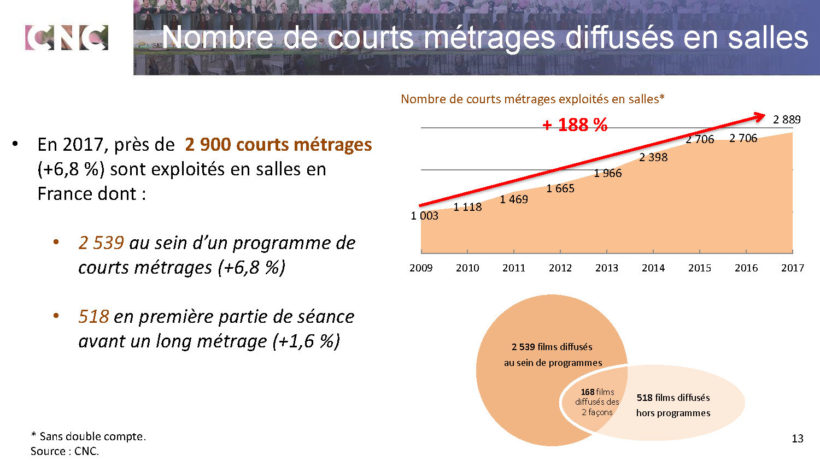
“Le marché du court métrage en 2017”, Présentation de l’étude, S. 13, CNC 2019
For the ninth time in a row, the French Centre national du cinéma et de l’image (CNC) has published a study on the situation of short film in France. The key questions were: What kind of short films are produced, how are they financed and what distribution channels do they benefit from?
Here are some key figures from the study presented in early 2019: In 2017, the year of the analysis, 535 French short films received a ‘visa d’exploitation’. In total, including international productions, 2,889 different short films were shown in French cinemas.
The most astonishing result is probably the steadily growing number of short films in cinemas. Since the statistics began – the first study was published for the cinema year 2009 – the number of short films screened in cinemas has grown by 188% (see chart above)! It is remarkable that the number of screenings with short film programs grew disproportionately compared to the number of supporting films. In view of the decline in cinema admissions, however, no increases in admission figures were achieved. In the year under review there were 3.6 million admissions, of which 2.8 million were for short film programs (+1.7 %) and 0.8 million for screenings with supporting films (-1.2 %).
This increase is mainly due to the activities of the Agence du court métrage, which was able to increase its lending again compared to the previous year. The introduction of the “L’Extra Court” program with new tariffs, variable package offers and shorter films also contributed to this.
In addition to measures to support cinema pre-films, physical media and video on demand, the CNC also provided €456 800 for supporting the screening of 18 short film programmes in cinemas.
Other figures
Out of the 2,889 short films, 60 % originated from France, 22.2 % from the rest of Europe and 28.9 % from other countries.
87% of French cinemas showed a short film in 2017. 875 European titles were shown on television in 2017. Arte accounted for 210 of these films. The remaining 264 films were shown on free channels and 611 on pay-TV channels.
44 % of the annual production was privately financed, compared with 46.6 % from public funds (subsidies) and 9.4 % from foreign financing. CNC production funding totalled € 13.9 million, an increase of 17% over the last 5 years.
73.5 % of production was short fictional films (66 % in 2015), followed by documentaries and experimental films (16.7 %), which were grouped together for the first time, and 9 % animated films. The average running time of a film was 22 minutes and the average cost was €84,800. With an average age of 37 years, 68.2% of the producers (directors) were men.
The most important foreign market for French short films was Western Europe, followed by Asia and the USA. The biggest sales successes were achieved by animated films. Most contracts were concluded in the cinema sector (59.6 %). However, the cinema sector only accounted for 16.9 % (€ 91.7K) of the total volume. The share of transactions in the video-on-demand sector was second only to the television market at 9.5 % – but this was more than a doubling of the share compared to the previous year. The volume on the VoD market was € 59.1K.
The most economically successful films in 2017 were the short fiction film MARLON by Jessica Palud and the 3D animation film TROIS PETIT CHATS – a collective work of students from the private Rubika schools in Valenciennes and Montréal.
In the cinema, three films from the animated film series “Ernest et Célestine en hiver” were at the top of the most viewed short films (LE BOUTON D’ACCORDÉON, LE BAL DES SOURIS and BIBI).
These and many other information and figures can be read and downloaded as PDF in the study “Le marché du court métrage en 2017”, a 60 page long and very detailed report.
Source: “Le marché du court métrage en 2017” , pdf, CNC 2019
pictures
titel picture (above): Le marché du court métrage en 2017, Présentation de l’étude, page 13, CNC 2019
contribution picture on main page: LE BOUTON D’ACCORDÉON, FOLIVARI / MELUSINE PRODUCTIONS / SO-NORD / RTBF (télévision belge) – OUFtivi / Distribution: Dandeloo